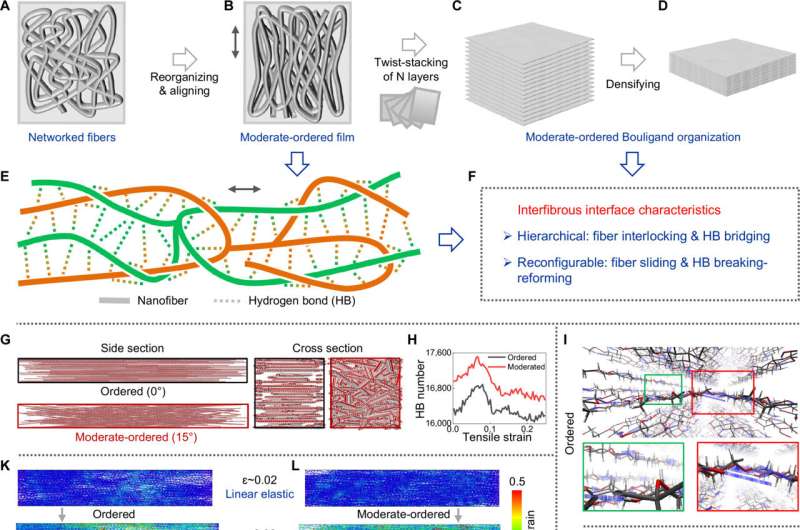This article has been reviewed according to Science X's editorial process and policies. Editors have highlighted the following attributes while ensuring the content's credibility:
fact-checked
peer-reviewed publication
proofread
Researchers develop bioinspired Bouligand structure for enhanced mechanical properties

Bouligand structures, found in natural materials like fish scales, lobster peritoneum and bones, are known for providing exceptional mechanical properties to biomaterials. While progress has been made in creating bioinspired materials, most research has focused on putting the fibers together. A deeper understanding of how the fibers interact to enhance the mechanical functions is needed now.
A research team led by academician Yu Shuhong of the University of Science and Technology of China (USTC) of the Chinese Academy of Sciences (CAS) has introduced a bioinspired Bouligand structure with a hierarchical and reconfigurable interfibrous interface that significantly boosts mechanical strength and toughness through dynamic load transfer and energy dissipation, offering a new strategy for creating advanced structural materials.
The paper is published in the journal Science Advances.
The team had initially used bacterial cellulose nanofibers as a model matrix but struggled to understand how nanofiber orientation influenced micromechanical behavior. To tackle this problem, they conducted large-scale molecular dynamics simulations with different orientation angles.
The results revealed that optimizing the hydrogen-bonding network dimension through cross-linking structures improved load transfer capacity and damage resistance.
Moreover, the team observed that excessive orientation angles weakened load transfer efficiency and interchain hydrogen bond density, resulting in decreased mechanical properties. This highlighted the importance of moderate orderliness for optimal interfacial interaction.
Moderate orderliness integrated microstructure and hydrogen bonding, outperforming high structural orderliness due to tradeoffs among structural orientation, fiber interlocking and hydrogen bonding network dimensions.
In addition, the team identified a large shadow zone around cracks, and revealed micro-motion of nanofiber primitives. Cross-polarizing light was used to monitor this micro-motion within the membrane layer, enabling the preparation of bioinspired Bouligand structural materials with multiscale coupling through helical stacking and hot-press densification.
USTC's bioinspired Bouligand structure enabled by moderate orderliness exhibits outstanding mechanical properties and dimensional stability, and may have applications in biomedical fields such as fibrocartilage tissue repair and replacement.
More information: Si-Ming Chen et al, Hierarchical and reconfigurable interfibrous interface of bioinspired Bouligand structure enabled by moderate orderliness, Science Advances (2024). DOI: 10.1126/sciadv.adl1884
Journal information: Science Advances
Provided by University of Science and Technology of China





















